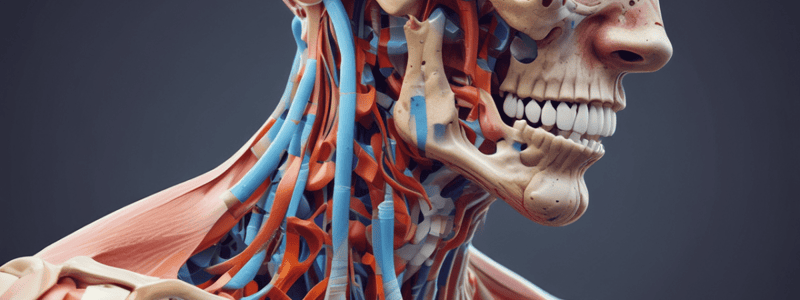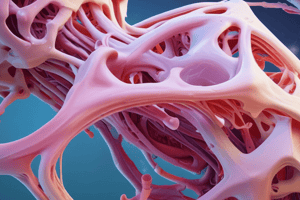Podcast
Questions and Answers
Ovoid joints have articular surfaces that are both convex.
Ovoid joints have articular surfaces that are both convex.
False (B)
Saddle joints have articular surfaces that are oriented at 90 degrees to each other.
Saddle joints have articular surfaces that are oriented at 90 degrees to each other.
True (A)
Synovial fluid is responsible for increasing friction in diarthrodial joints.
Synovial fluid is responsible for increasing friction in diarthrodial joints.
False (B)
Arthrokinematics describes the motion of bones relative to the three cardinal planes of the body.
Arthrokinematics describes the motion of bones relative to the three cardinal planes of the body.
Compression forces in a joint cause the articular surfaces to move closer together.
Compression forces in a joint cause the articular surfaces to move closer together.
Joint play is not necessary for the articular surfaces to slide in the direction of the desired movement of the distal end of the bone.
Joint play is not necessary for the articular surfaces to slide in the direction of the desired movement of the distal end of the bone.
Syndesmoses are fibrous joints where two bones are held together by an interosseous membrane.
Syndesmoses are fibrous joints where two bones are held together by an interosseous membrane.
Sutures are fibrous joints that eventually turn into synostoses.
Sutures are fibrous joints that eventually turn into synostoses.
Symphyses are cartilaginous joints where two bony components are joined by fibrocartilage disks.
Symphyses are cartilaginous joints where two bony components are joined by fibrocartilage disks.
Synchondroses are primary cartilaginous joints that eventually turn into synostoses.
Synchondroses are primary cartilaginous joints that eventually turn into synostoses.
Hinge joints and pivot joints are examples of uniaxial synovial joints.
Hinge joints and pivot joints are examples of uniaxial synovial joints.
Saddle joints are examples of biaxial synovial joints.
Saddle joints are examples of biaxial synovial joints.
Viscoelastic materials are not sensitive to the duration of the force application.
Viscoelastic materials are not sensitive to the duration of the force application.
Creep is a time-dependent property of viscoelastic materials.
Creep is a time-dependent property of viscoelastic materials.
Increasing the temperature of a connective tissue structure will decrease the rate of creep.
Increasing the temperature of a connective tissue structure will decrease the rate of creep.
Viscoelastic materials exhibit greater resistance to deformation when loaded rapidly compared to when loaded slowly.
Viscoelastic materials exhibit greater resistance to deformation when loaded rapidly compared to when loaded slowly.
Healthy tissues are not able to resist changes in their shape.
Healthy tissues are not able to resist changes in their shape.
The same forces that move and stabilize the body cannot deform or injure the body.
The same forces that move and stabilize the body cannot deform or injure the body.
The end feel is a physiological barrier to range of motion.
The end feel is a physiological barrier to range of motion.
Osteokinematics refers to the movement of bones within a joint.
Osteokinematics refers to the movement of bones within a joint.
Type I collagen fibers are thin and easily stretched.
Type I collagen fibers are thin and easily stretched.
Hypermobility refers to an abnormal increase in joint range of motion.
Hypermobility refers to an abnormal increase in joint range of motion.
Collagen fibers make up 90% of all proteins in the body.
Collagen fibers make up 90% of all proteins in the body.
The concept of kinematic chains is useful for analyzing human motion.
The concept of kinematic chains is useful for analyzing human motion.
Bone has a cancellous outer cortex and a compact supporting core.
Bone has a cancellous outer cortex and a compact supporting core.
Bone is a highly dynamic tissue with a poor potential for healing.
Bone is a highly dynamic tissue with a poor potential for healing.
Bone is a specialized connective tissue that is mechanically optimized to resist compressive forces.
Bone is a specialized connective tissue that is mechanically optimized to resist compressive forces.
Viscoelastic materials exhibit only the properties of elasticity, not viscosity.
Viscoelastic materials exhibit only the properties of elasticity, not viscosity.
Tissues with high viscosity exhibit low resistance to deformation and have a lower ability to dampen shearing forces.
Tissues with high viscosity exhibit low resistance to deformation and have a lower ability to dampen shearing forces.
Bone cells called osteocytes are found within the Haversian canal system, which provides a rich source of blood and nerves.
Bone cells called osteocytes are found within the Haversian canal system, which provides a rich source of blood and nerves.




